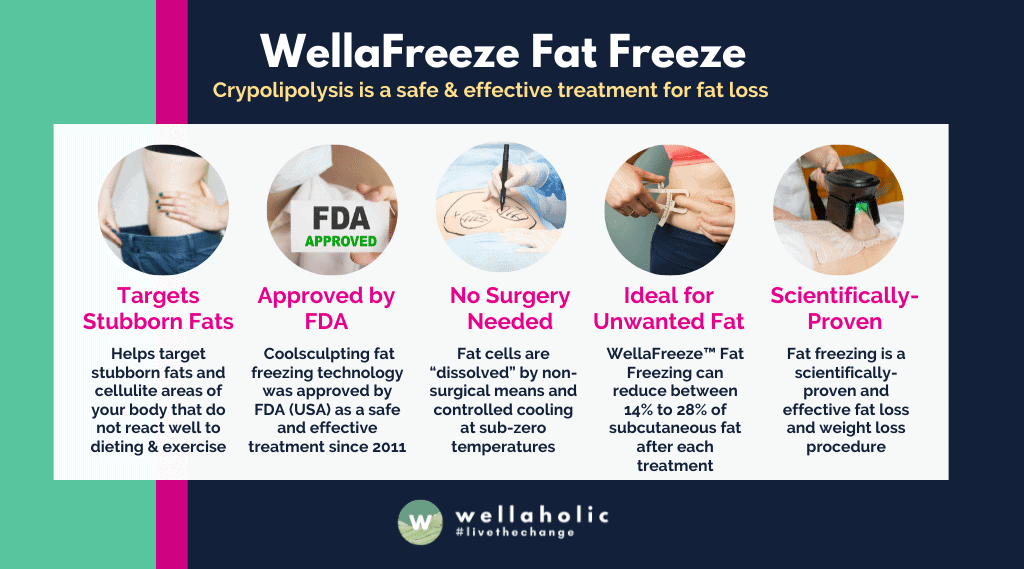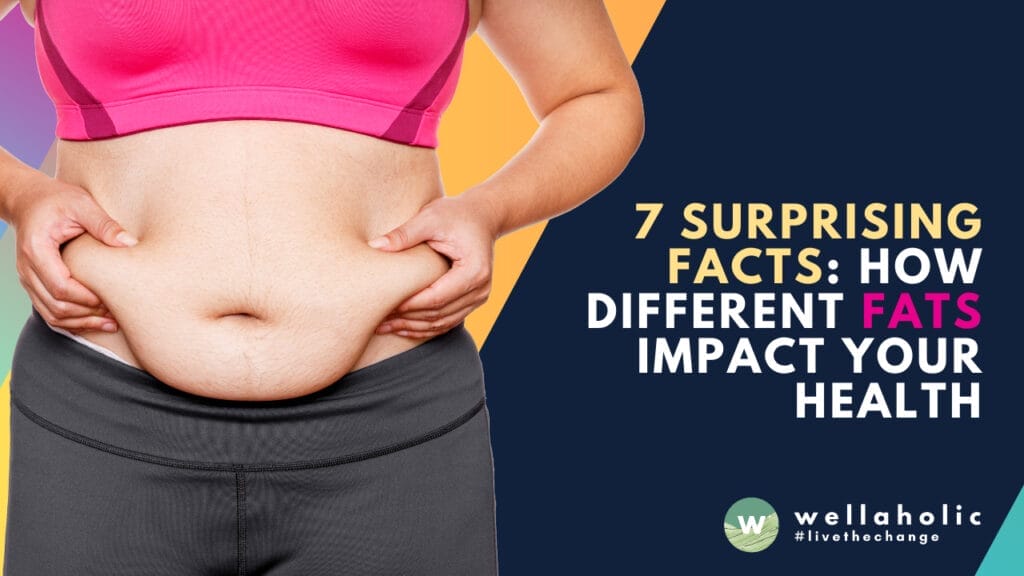
Eat Fat, Get Fit? 7 Mind-Blowing Facts About Fats You Need to Know

🍎 Best Foods to Reduce Weight
📊 Weight Loss Facts
🥗 Top Weight Loss Foods
💡 Pro Weight Loss Tips
🚀 Ready to Start Your Weight Loss Journey?
Combine healthy eating with professional slimming treatments for faster results!
Book Your Consultation Today! 📞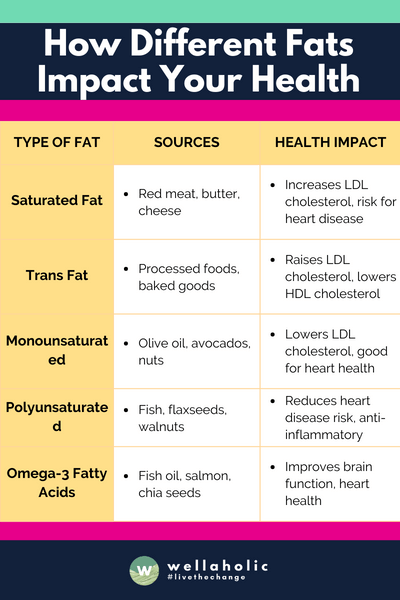
Introduction
Have you ever wondered why some fats are considered “good” while others are labeled “bad”?
As aesthetic professionals with years of experience, we’ve seen how different fats can affect our customers’ health and appearance. At Wellaholic, we often get questions about dietary fats and their impact on skin health and weight management.
In this article, we’ll share seven surprising facts about how various fats influence your overall well-being. We’ll draw on our knowledge from working with customers in Singapore and Australia, as well as the latest research in nutrition and aesthetics. Our goal is to help you make informed choices about the fats in your diet and their effects on your body. Let’s dive into these eye-opening facts that might change how you view fats in your daily meals.

Saturated Fats: Not All Bad?
We’ve seen a lot of confusion among our customers at Wellaholic about saturated fats. Are they good or bad? The truth is, it’s not that simple. Saturated fats are found in foods like meat, dairy, and coconut oil. They’ve been linked to higher cholesterol levels, but new research shows they might not be as harmful as we once thought.
At Wellaholic, we believe in looking at the whole picture. Not all saturated fats are created equal. Whole foods like grass-fed beef or full-fat yogurt can be part of a healthy diet. They’re packed with nutrients and can be satisfying. On the flip side, processed foods high in saturated fats, like packaged snacks or fast food, are best avoided. We always encourage our customers to focus on whole, unprocessed foods for better overall health.
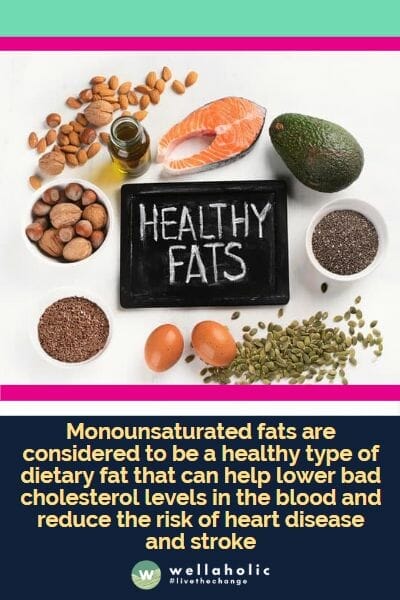
Monounsaturated Fats: Heart’s Best Friend
At Wellaholic, we often talk to our customers about the importance of a heart-healthy diet. Monounsaturated fats are a key part of this. These good fats help lower bad (LDL) cholesterol while keeping good (HDL) cholesterol levels steady. This balance is crucial for heart health. We’ve seen how small changes in diet can make a big difference.
We always suggest easy ways to add more monounsaturated fats to meals. Olive oil, avocados, and nuts are great options. For example, we tell our customers to use olive oil instead of butter when cooking. Or to snack on a handful of almonds instead of chips. These simple swaps can boost heart health over time. It’s not about cutting out all fats, but choosing the right ones.
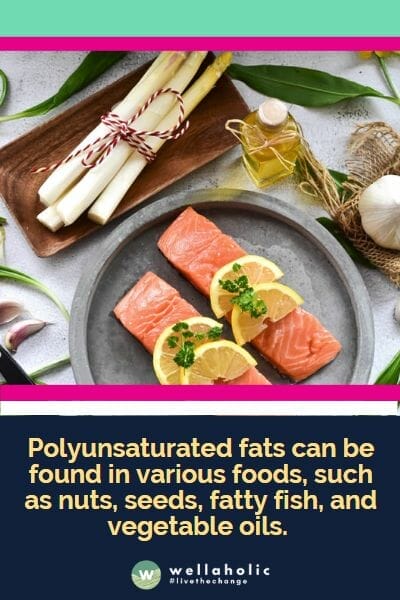
Polyunsaturated Fats: Essential for Body Function
We at Wellaholic often get asked about healthy fats. Polyunsaturated fats are a key part of a balanced diet. These fats come in two main types: omega-3 and omega-6 fatty acids. You can find them in foods like fish, nuts, and plant oils. Our customers at Wellaholic are often surprised to learn that these fats are essential for our bodies. We can’t make them on our own, so we need to get them from food.
Polyunsaturated fats do a lot of good for our health. They help keep our hearts strong by lowering bad cholesterol. They also fight inflammation in the body. We’ve seen how adding more of these fats to their diets has helped many of our customers feel better overall. Some good sources include salmon, walnuts, and sunflower oil. We always suggest small changes, like swapping butter for olive oil, to boost intake of these healthy fats.
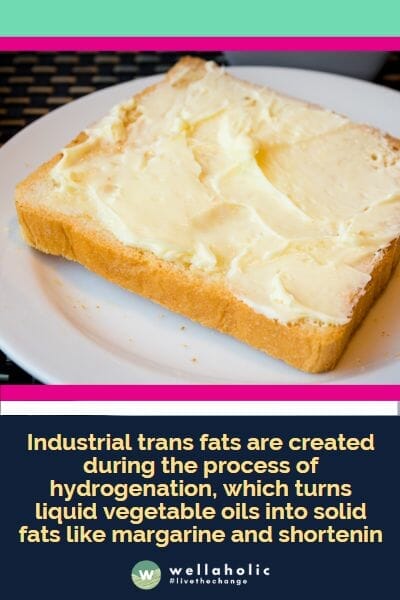
Trans Fats: The Hidden Danger
We at Wellaholic often get questions about trans fats from our customers. Let’s break it down for you. Trans fats come in two types: natural and artificial. Natural trans fats are found in small amounts in some animal products. But the real troublemakers are artificial trans fats, which are made by adding hydrogen to vegetable oils. These are the ones we need to watch out for.
Why are trans fats bad? They raise your “bad” cholesterol and lower your “good” cholesterol. This can lead to heart disease and other health problems. To avoid them, we always tell our customers to check food labels. Look for “partially hydrogenated oils” in the ingredients list. That’s a red flag for trans fats. Instead, choose foods with healthier fats like olive oil, avocados, and nuts. At Wellaholic, we believe small changes in your diet can make a big difference in your health and appearance.
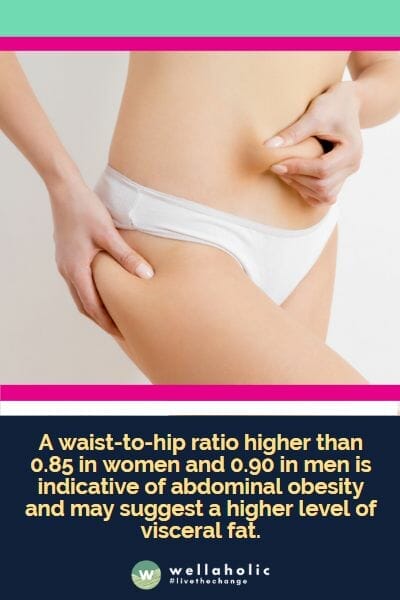
Visceral Fat: The Silent Health Threat
We at Wellaholic often see customers who are concerned about their belly fat. But not all fat is the same. Visceral fat is the hidden fat that wraps around your organs deep inside your belly. It’s different from the fat you can pinch under your skin, which we call subcutaneous fat. While you can’t see visceral fat, it can be more harmful to your health than the fat you can see.
Measuring visceral fat isn’t as simple as stepping on a scale. We use the waist-to-hip ratio as a quick way to check for it. To do this, we measure the waist and hips, then divide the waist size by the hip size. A high ratio can mean more visceral fat. We also pay close attention to waist size. For women, a waist over 35 inches (89 cm) is a red flag. For men, it’s 40 inches (102 cm). These measurements help us spot potential health risks and guide our customers towards better wellness choices.
“Visceral fat is not just a harmless storage depot for excess calories, but is an active organ capable of secreting harmful chemicals into the body”

The Waistline-Health Connection
We’ve seen many customers at Wellaholic who are concerned about their waistline. It’s not just about looks – there’s a real health connection here. Studies show that a larger waist size can increase the risk of early death. For men, a 4-inch increase in waist size bumps up this risk by 16%. For women, it’s even higher at 25%. These numbers got our attention.
So what’s a healthy waist size? For men, it’s under 40 inches. For women, it’s under 35 inches. But don’t worry if you’re above these numbers. Small changes can make a big difference. We suggest our customers focus on eating more fruits and veggies, moving their bodies daily, and getting enough sleep. These simple steps can help trim the waistline and boost overall health. Remember, it’s not about being perfect. It’s about making progress towards a healthier you.
“The types of fats we consume can have a profound effect on our longevity – choose wisely!”
Table: Different Types of Fats and Health Implications
It’s no secret that fats play an important role in our diets. But did you know that not all fats are created equal? It’s true! From saturated to unsaturated, and even trans fats, each type has its own unique set of health implications. Saturated fats may increase your risk of heart disease, while unsaturated fats can help lower cholesterol levels. And as for trans fats? Well, let’s just say they’re about as welcome in your diet as a clown at a funeral. So, if you’re looking to keep your body happy and healthy, it’s important to choose your fats wisely.
| Type of Fat | Description | Food Sources | Health Implications |
|---|---|---|---|
| Saturated Fat | Solid at room temperature, comes mostly from animal sources | Meat, butter, cheese, cream | Linked to an increased risk of heart disease when consumed in excess |
| Monounsaturated Fat | Liquid at room temperature, helps reduce bad cholesterol | Olive oil, avocado, nuts, seeds | May help reduce the risk of heart disease |
| Polyunsaturated Fat | Liquid at room temperature, includes omega-3 and omega-6 fatty acids | Fatty fish, flaxseed, sunflower oil | May help reduce the risk of heart disease and support brain health |
| Trans Fat | Man-made, typically found in processed foods | Margarine, packaged snacks | Can raise bad cholesterol levels and increase the risk of heart disease |
Balancing Different Fats for Optimal Health
We’ve seen many customers at Wellaholic struggle with understanding fats in their diet. It’s not just about cutting out all fats – it’s about finding the right balance. Our bodies need a mix of different fats to work well. We aim for about 20-35% of daily calories from fat, with most coming from healthy sources like olive oil, nuts, and fish.
To help our customers eat better fats, we share some easy tips. We suggest planning meals with a good fat source, like adding avocado to a salad or using olive oil for cooking. When it comes to cooking methods, we recommend gentle heating to keep the good fats intact. Steaming, baking, or light sautéing are great options. By making these small changes, we’ve seen many of our customers improve their overall health and feel more energized.

Conclusion: The Fat Truth for Thriving Health
We’ve seen many customers at Wellaholic struggle with understanding fats. It’s not as simple as “fat is bad.” There are different types of fats, and each affects our bodies in unique ways. Some fats, like those in avocados and nuts, can actually be good for us. Others, like trans fats in processed foods, are best avoided. The key is to make smart choices about the fats we eat.
In our years of experience, we’ve learned that a balanced approach to fat is crucial for long-term health. We encourage our customers to include healthy fats in their diets while limiting unhealthy ones. This doesn’t mean cutting out all fats – it’s about finding the right balance. When people understand the different types of fats, they can make better food choices. This knowledge leads to improved health and well-being over time. Remember, small changes in your diet can make a big difference in how you look and feel.
Frequently Asked Questions (FAQ)
1. Is eating fat really good for weight loss?
Yes, consuming healthy fats can actually support weight loss and overall fitness. Contrary to outdated beliefs, not all fats are harmful. Healthy fats like avocados, nuts, and olive oil provide essential fatty acids that boost metabolism and reduce cravings by promoting satiety. At Wellaholic, we’ve seen clients who incorporate balanced amounts of healthy fats into their diets experience better energy levels and improved body composition. These fats also help regulate hormones, which play a crucial role in maintaining metabolic health.
🔵 Healthy fats increase satiety, reducing overeating.
🔵 They support hormone production for a faster metabolism.
🔵 Omega-3s in fats reduce inflammation linked to weight gain.
🔵 Avocados and nuts are nutrient-dense, aiding sustained energy.
🔵 Monounsaturated fats improve insulin sensitivity.
🔵 Including fats helps balance macronutrient intake effectively.
2. What are the best sources of healthy fats for Singaporeans?
Singapore’s diverse food culture offers plenty of options for incorporating healthy fats into your diet. Foods like salmon, chia seeds, coconut oil, and even local dishes with lean meats and vegetables cooked in minimal oil can be excellent choices. Wellaholic emphasizes the importance of selecting fats that align with individual health goals while considering cultural preferences. For instance, using less palm oil and opting for cold-pressed oils can make a significant difference.
🔵 Salmon is rich in omega-3s, supporting heart and brain health.
🔵 Coconut oil contains medium-chain triglycerides (MCTs) for quick energy.
🔵 Chia seeds offer fiber and antioxidants along with healthy fats.
🔵 Nuts like almonds and walnuts are portable, convenient snacks.
🔵 Lean meats prepared with herbs retain flavor without excess fat.
🔵 Local soups with leafy greens add nutrients alongside healthy fats.
3. How do fats affect skin health and aging?
Healthy fats play a vital role in maintaining youthful, glowing skin. Fats contribute to the production of collagen and elastin, which keep skin firm and supple. In humid climates like Singapore’s, proper hydration combined with omega-3 fatty acids from fish or flaxseeds can combat dryness and irritation. At Wellaholic, we recommend clients include these fats as part of an anti-aging regimen to enhance skin elasticity and reduce fine lines naturally.
🔵 Omega-3s hydrate skin cells, preventing dryness and flakiness.
🔵 Vitamin E in nuts protects against UV damage and premature aging.
🔵 Avocado promotes collagen synthesis for firmer skin texture.
🔵 Olive oil reduces oxidative stress linked to wrinkles.
🔵 Saturated fats in moderation strengthen the skin barrier.
🔵 Balanced fat intake supports hormonal balance affecting skin clarity.
4. Can eating fat improve heart health?
Contrary to popular belief, certain types of dietary fat can significantly benefit cardiovascular health. Unsaturated fats, such as those found in olive oil, fatty fish, and avocados, lower bad cholesterol (LDL) while increasing good cholesterol (HDL). This balance is critical in preventing heart disease, especially in urban settings like Singapore where sedentary lifestyles are common. Wellaholic’s nutritional coaching focuses on educating clients about smart fat choices to protect long-term heart health.
🔵 Monounsaturated fats reduce LDL cholesterol levels effectively.
🔵 Omega-3 fatty acids decrease triglycerides and blood pressure.
🔵 HDL cholesterol supports artery function and reduces plaque buildup.
🔵 Plant-based fats like nuts lower the risk of coronary diseases.
🔵 Replacing trans fats with healthy fats improves circulation.
🔵 A Mediterranean-style diet rich in fats benefits heart longevity.
5. Do fats impact mental clarity and focus?
Absolutely! Fats are crucial for brain function since they make up nearly 60% of the brain’s structure. Consuming adequate amounts of omega-3 fatty acids enhances cognitive performance, memory retention, and mood stability. Given Singapore’s fast-paced lifestyle, many individuals overlook this connection between diet and mental wellness. At Wellaholic, we guide clients toward including brain-boosting fats like walnuts, eggs, and fatty fish to sharpen focus and sustain mental energy throughout busy days.
🔵 Omega-3s in fish improve concentration and memory recall.
🔵 DHA supports neuron communication for optimal brain activity.
🔵 Eggs contain choline, essential for neurotransmitter production.
🔵 Walnuts are packed with antioxidants that protect brain cells.
🔵 Coconut oil provides ketones, alternative fuel for the brain.
🔵 Balanced fat intake stabilizes mood swings and anxiety.
6. How much fat should I eat daily for optimal results?
The ideal amount of fat varies based on age, activity level, and personal goals, but generally, 20-35% of your total daily calories should come from fats. For active individuals in Singapore, slightly higher fat intake may be beneficial to meet energy demands. Wellaholic tailors personalized plans ensuring clients consume the right types and amounts of fats for their unique needs, avoiding both deficiencies and excesses.
🔵 Aim for 20-35% of daily calories from healthy fat sources.
🔵 Adjust fat intake based on physical activity and fitness goals.
🔵 Prioritize unsaturated fats over saturated ones for better outcomes.
🔵 Avoid processed foods high in unhealthy trans fats.
🔵 Track fat consumption using apps or meal planning tools.
🔵 Consult professionals for tailored advice on fat requirements.

Serene Chiam, Aesthetic Director (LinkedIn)
Serene Chiam, the Aesthetic Director at Wellaholic, brings a wealth of knowledge and experience to the Singapore aesthetic scene. With over ten years of expertise in body sculpting and fat freezing treatments, Serene has helped numerous clients achieve their body goals through cutting-edge technologies like WellaFreeze and cryolipolysis. Her CIDESCO certificate in skincare and Bachelor of Health Science (Aesthetics) from Torrens University of Australia showcase her dedication to providing the highest quality treatments backed by science. Having previously served as a Clinical Aesthetics Manager with Laser Clinics Australia, Serene’s extensive background in the aesthetics industry has solidified her reputation as a trusted expert in non-surgical fat reduction solutions.
Contact Serene at [email protected]
GET IN TOUCH
Book Now Pay Later

WellaFreeze™ 360 Advanced Fat Freezing
- ⭐ Latest 4th Generation Freezing. WellaFreeze™ 360 advanced fat freezing uses the latest fat freeze technology for the highest fat reduction per session.
- ⭐ Up to 34% Fat Loss Each Session. Increase in percentage of fat loss due to newer technology and coverage.
- ⭐ 360° Surround Cooling Technology. The handles or cooling cups can be adjusted to fit all body curves and contouring for best freezing.
- ⭐ Breathing Technology Reduces Bruising. “Breathing” technology improves freeze while minimising bruising from the suction.
- ⭐ Shorter Time Needed. Each duration is reduced from typical 60 minutes to just 30 minutes.
- ⭐ Award-Winning. Wellaholic’s treatments have been recognized by top beauty publications such as Daily Vanity, Beauty Insider, and Tropika Club Magazine.
- ⭐ Over 2000 Verified Customer Reviews. Wellaholic has over 2000 positive reviews from customers, and >50% are repeat customers.
